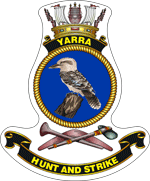HMAS Yarra (U77)
| 300px HMAS Yarra | |
| Career (Australia (RAN)) | |
|---|---|
| Namesake: | Yarra River |
| Builder: | Cockatoo Island Dockyard |
| Laid down: | 24 May 1934 |
| Launched: | 28 March 1935 |
| Commissioned: | 19 December 1935 |
| Motto: | "Hunt and Strike" |
| Honours and awards: |
Battle honours: Libya 1941[1] |
| Fate: | sunk by Japanese cruisers Atago and Takao 300 mile south of Java on 4 March 1942 |
| Badge: |
 |
| General characteristics | |
| Class and type: | Grimsby class sloop |
| Displacement: | 1,060 tons (standard), 1,515 tons (full load) |
| Length: | 266 ft (81 m) |
| Beam: | 36 ft (11 m) |
| Draught: | 7 ft 6 in (2.29 m) |
| Propulsion: | Parsons, steam turbines, 2 shafts. 2,000 shp |
| Speed: | 16.5 knots |
| Complement: | 135 |
| Armament: |
3 x QF 4-inch (101.6 mm) Mk XVI anti-aircraft guns 4 x QF 3 pounder guns 1 x MG 2 x Depth Charge Throwers 2 x twin tubes for 21 inch torpedoes |
HMAS Yarra (U77), named for the Yarra River, was a Grimsby class sloop of the Royal Australian Navy (RAN) that served during World War II. Commissioned in 1936, Yarra remained in service until 4 March 1942, when she was sunk while defending a convoy from five Japanese warships.
Construction
Yarra was laid down by the Cockatoo Island Dockyard at Sydney, New South Wales on 24 May 1934, launched on 28 March 1935 by Mrs Parkhill, wife of Archdale Parkhill, Minister for Defence, and commissioned into the RAN on 21 January 1936.
Operational history
| |
This section requires expansion. |
Sinking
Early on 4 March 1942, Yarra, commanded by Lieutenant Commander Robert William Rankin RAN, was escorting a convoy near Tjilatjap in the Indian Ocean. Yarra was attacked by the Japanese cruisers Atago, Takao, and Maya, which were accompanied by two destroyers of Japanese Destroyer Division 4: Arashi and Nowaki.
Commander Rankin ordered the convoy to scatter and ordered Yarra to turn and engage the enemy. The sloop was able to engage the Japanese ships for over an hour and a half, before she sank with the loss of 138 of the 172 aboard at the time (Yarra had rescued survivors from the Dutch ship Parigi the day before). Of the 34 survivors, 13 were rescued by Dutch submarine K-XI five days after the sinking, while 21 either died on the liferafts or were never seen again.
Australian War Memorial historian Daniel Oakman wrote that the defence mounted by Yarra was "widely regarded as one of the bravest acts in Australian naval history".[citation needed]
See also
References
| 50x40px | This article includes a list of references or external links, but its sources remain unclear because it has insufficient inline citations. Please help to improve this article by introducing more precise citations where appropriate. (August 2009) |
- ↑ Festberg, Alfred N. (1981). Heraldry in the Royal Australian Navy. Melbourne, VIC: Silverleaf Publishing. p. 73. ISBN 0949746002. OCLC 9780949746009.
- Warships of Australia, Ross Gillett, Illustrations Colin Graham, Rigby Limited, 1977, ISBN 0-7270-0472-7
External links
| 40px | This article about a specific Australian naval ship or boat is a stub. You can help Ship Spotting World by expanding it. |
| This Australian World War II article is a stub. You can help Ship Spotting World by expanding it. |
- Pages with broken file links
- Articles to be expanded from August 2009
- Articles with invalid date parameter in template
- All articles to be expanded
- All articles with unsourced statements
- Articles with unsourced statements from August 2008
- Articles lacking in-text citations from August 2009
- All articles lacking in-text citations
- Grimsby class sloops
- Royal Australian Navy sloops
- World War II shipwrecks in the Indian Ocean
- 1935 ships
- Australian naval ship stubs
- Australian World War II stubs
